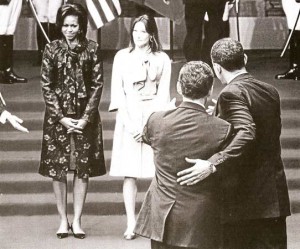 A photo in this weekend’s Globe and Mail caught my eye: US First Lady Michelle Obama and French First Lady Carla Bruni-Sarkozy were standing at attention with their husbands in the foreground during the NATO summit in Strasbourg. My attention was fixed not on the content, but on the exposure of the photograph. Ms. Obama was dressed in a rather dark dress, and Ms. Sarkozy was in white. The extreme dynamic range of the scene required a decision: do we expose for the black woman, or the white woman? And in this case, the black woman took precedence, resulting in a totally washed-out Ms. Sarkozy.
A photo in this weekend’s Globe and Mail caught my eye: US First Lady Michelle Obama and French First Lady Carla Bruni-Sarkozy were standing at attention with their husbands in the foreground during the NATO summit in Strasbourg. My attention was fixed not on the content, but on the exposure of the photograph. Ms. Obama was dressed in a rather dark dress, and Ms. Sarkozy was in white. The extreme dynamic range of the scene required a decision: do we expose for the black woman, or the white woman? And in this case, the black woman took precedence, resulting in a totally washed-out Ms. Sarkozy.
This made me wonder: now that there is a black President, will photojournalists be “stopping up” their lenses to make black faces more visible? Most of us have friends with black skin, and I am certain that I am not the only one to feel frustration that photos taken of black people are pathetically underexposed. Automatic exposure on consumer-grade cameras has yet to catch up with the reality of skin colour; I suspect that exposure levels are optimized for Japanese and (perhaps) Caucasian skin tones.
Will the Election of a Black President Spur the Adoption of HDR Technology?
It’s one thing for Asian digital camera companies to tweak their exposure software, but this is really a stopgap until the widespread adoption of the next frontier of digital photography: “high dynamic range” or “HDR.”
We now have consumer-grade digital cameras that are capable of exceeding the resolution of 35mm film. But the film negative has a dynamic range (the ability to capture lights and darks) that exceed digital capabilities by an order of magnitude. Here’s an excellent discussion of the issue. Using HDR, a photographer can make a best guess when taking the picture, and use the flexibility afforded by the additional dynamic range—this is known as “tone mapping”—to get a photograph where both Michelle and Carla are perfectly exposed.
Flickr has a good assortment of HDR photos.